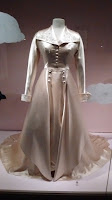 |
| 1945 |
Costume and Lace Museum
Brussels March 2017
A favourite museum in
one of my favourite cities.
The current
exhibition is ‘A History Of Marriage’
There are cases full
of dresses from someone’s dream day. At least I hope so.
I began my visit gazing at a rare white 1830s
gown that looked so tiny yet had such big sleeves. The scalloped skirt frill
and hem were lovely. This is the hardest kind of dress for me to actually
imagine someone wearing. It reminds me of the doll in Coppélia.1875 and the
ruching, ruffles, frills and lace on show exactly matched the description
of ‘excessive ornamentation’ (designed to mimic the style of upholstery of the
time).Wax flowers worn as a corsage on the shoulder sat well above a lot of
draping and swathing from 1890. A blizzard of ivory and white, satin,
tulle and chiffon took me through 1895 with its high necked, tiny waisted,
tight sleeved confection with a long train would have meant movement was at
best minimal and at worst impossible.
As this is the lace museum the wedding hankie
on shown was perfection. These hankies were a very important accessory for
an elegant bride in the 19th century, often decorated with the husband to
be and the brides initials. There was a dress from c1910 that reminded me of
the style of the late Queen Elizabeth The Queen Mother. It looked fragile and
lovely in ivory damask silk with chiffon sleeves and embroidered pearls. The
treats just kept on coming. Irish lace and braiding on an ivory woollen
1910 dress.
Then ivory satin from 1949, quite like a
riding outfit from the 18th century. More ivory satin from 1957, this one
sparkling in strass and pearls. A dress inspired by Schiaparelli and made
in ivory silk satin by the bride and her sister in 1948 had the most dramatic
slash of fabric falling from right to left on the skirt. It worked perfectly as
the rest of the dress was so stark. Declaring an interest here. I got married
in the 1970s. My choice of medieval sleeves seemed spot on then and if Game of
Thrones ever need an extra, I’m there. Representing this era, (one that has come
into such criticism,mainly from people who have no memory of what the 1980s
were like)…were huge bishop sleeves on a flowing white creation from 1973. It
had a few random daises strewn across it. Very simplistic but a little bare I
thought, as it looked as if they only had a few daises to spare. As I say, The
Eighties. 19 not 18. Well. The example of high fashion for that era was in the
style of a pair of hair salon curtains in bright white nylon. A long ruched
neck to hip top, then two big flounces. Plus some puffy long sleeves. I can’t
rule out shoulder pads. I rest my case.
 |
| 1830s |
 |
| 1875 |
 |
| 1895 |
 |
| 1890 |
 |
| c1910 |
 |
| 1910 |
 |
| 1910 |
 |
| 1948 |
 |
| 1957 |
 |
| 1973 & 1980s |
 |
| John Galliano s/s 2010 |
 |
| 1907 |
 |
| 1907 |
The centrepiece gown was a Galliano s/s 2010
HC gown composed of a long sleeved corset style top with attached suspenders
and a skirt of feathers over a crinoline shape. The top was white and that was
about the only thing weddingy about it in my opinion. Definitely JG in his
other worldly dramatic phase. Tucked away in a corner was a blue 1755-1760 Mantua style gown in silk lampas. The notes
report that it was difficult to say whether a dress was specifically a wedding
dress from this period, but as the whole underskirt is rich fabric and not
merely the bits that show, it seems probable that it was. The mannequin was
wearing a lace cap with lappets and the notes said that some people were of the
opinion that veils had originated from this cap style. I do see what they mean.
There was a black dress chosen by an 1858 bride for its practicality post
wedding. And a red shot silk taffeta and organza dress from 2000 that looked
straight out of a gothic novel. My favourite was a dress that was part of a
trousseau, not an actual wedding dress. Borrowing heavily from the First Empire
this perfectly lovely dress in white crêpe de chine glittered and sparkled with
pearls, silver thread and beads. It belonged to Princess Marie Bonaparte who
married her Prince in 1907. The creation of Parisian House Drecoll, it was part
of a trousseau that featured 108 pairs of shoes and eighty, yes eighty evening
dresses.
Brussels must have a great store of the artefacts that give us a
back story and dress the cases to perfection. Each exhibition, whatever the
theme, has exquisite pieces. Their collection of contemporary documents and
background literature must be huge.
One case had a Bridal Set from the 1880s. This
consisted of a box with one large and one small flounce and a matching hanky,
all in Point de Gaze lace. The names of all the brides who had worn the lace
were embroidered on the ribbon that held the lace in the box. Anne 1885.
Ghislaine 1909. Marguerite Daisy 1938. ( As any fule kno, Marguerite is the
French for daisy. I wonder why she had both names?)
Several aphorisms on the subject of marriage
were written on the walls of the ladies cloakroom. Sadly my nerve failed me
from venturing into the Gents to see if they had anything similar.
So the last word shall go to Oscar Wilde.
‘Le Mariage est la cause principale du
divorce’
All photographs from Brussels Museum.
 |
| Bridal Set |


















No comments:
Post a Comment